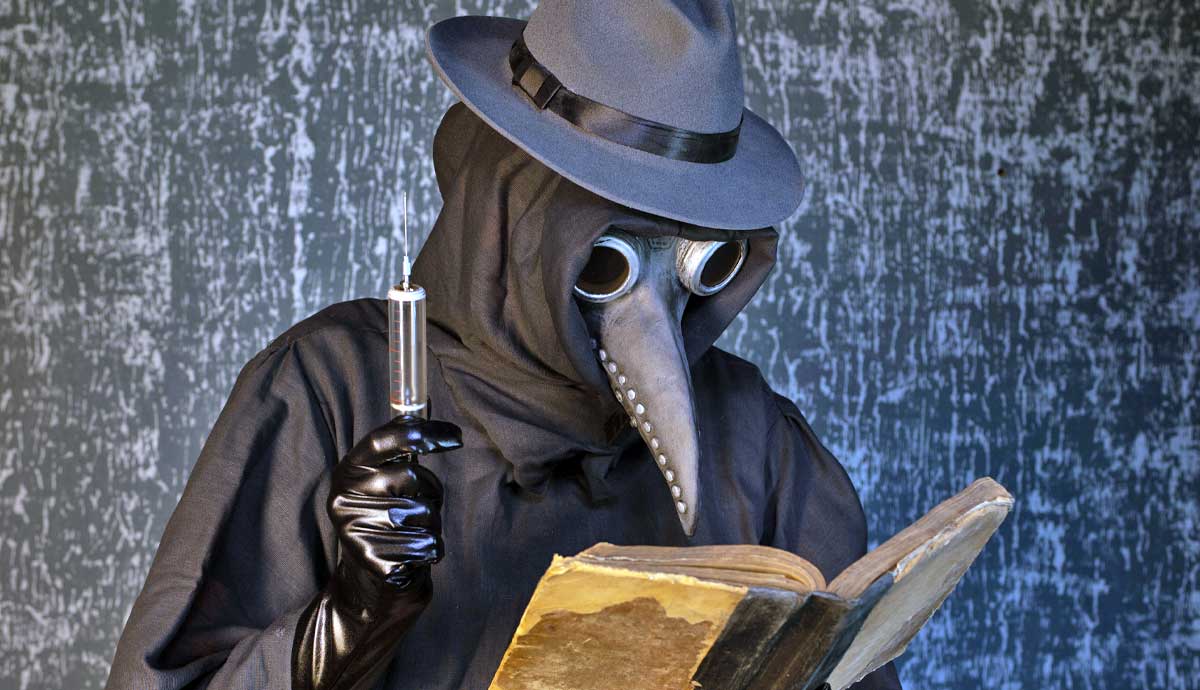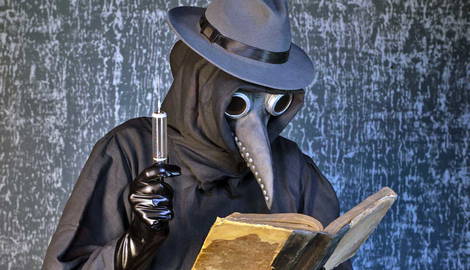
In Pandemic literature, authors from all over the world become historians documenting a time of harrowing experiences. In the ancient world, pestilence was a frequent calamity, and people rarely survived the terrible ravages. Those who did, turned their experience into moral tales of supernatural proportions. When the plague spread, no medicine could save lives, and the only way to escape it was to avoid contact with the infected people and abandon contaminated places.
What Inspired Pandemic Literature?

It was a God-fearing world, and in the absence of scientific knowledge that could explain the reasons behind the occurrence of pandemics, people turned to religion and superstitious beliefs to divine the supernatural origin of pandemics, believing it to be provoked by offenses against divinities. The Bible too helped expand this view of the plague as one of God’s punishments for sins. This was the root of the pandemics fictionalized by Homer and Sophocles in Iliad and Oedipus Rex. This belief was however refuted by the Greek historian Thucydides in his History of the Peloponnesian War, and the Latin poet Lucretius in his De Rerum Natura, who had more scientific turns of mind.
Pandemic literature explores the issues of trauma, catastrophe, suffering, existentialism, death and demise, displacement, and the ensuing psychological ordeals. Here are some of the written texts about pandemics that you should know.
Medieval Pandemic Literature

Geoffrey Chaucer’s stories in his The Book of the Duchess and The Canterbury Tales revolve around the sufferings that came with the Bubonic Plague of 1347. These texts serve as introspection about death and mortality, reactions to social chaos, and financial instability. The Decameron (1353) by Giovanni Boccaccio, is also set during the same Bubonic Plague, known as the Black Death. In Boccaccio’s work, ten people self-isolate in a villa outside Florence for two weeks. During the course of their isolation, they tell stories of morality, love, gender politics, passion, folly, and power.
Isolation and rampant deaths cause societal norms to collapse, which leads to a restructuring of everyday lives. But even in the ensuing chaos, the characters find a way to cope by telling stories. The writing emphasizes the fear of contagion increased vices such as avarice, greed, and corruption, which paradoxically led to infection and thus to both moral and physical death.

Daniel Defoe’s A Journal of the Plague Year (1722) from the Neoclassical Age is another long, detailed narrative of events, anecdotes, and statistics about the Great Plague of London in 1665. It captures human reactions to it—widespread panic, the malicious intents of opportunists, the fluctuating belief in God, and the attempts of the healthcare system to deal with it. It was based on Defoe’s uncle, Henry Foe’s journals. The work painstakingly presents tables of casualties to simulate verisimilitude, although it is classified as a historical novel.
Pandemic Tales of the Romantic Age

Mary Shelley’s The Last Man is one of the first pieces of dystopian fiction. It was published in 1826. The book takes place in the 21st century, in a world ravaged by a new version of the Bubonic Plague. The work focuses on a lot of interpersonal relations, intertwining hope, love, and faith. Mostly, however, it deals with the ideal man becoming a selfish, isolated entity focused on survival in the face of imminent disaster. The novel has a bittersweet resolution with the sole survivor searching for others. While primarily a commentary on the metaphorical plague of humans falling short of the ideal, it still compellingly depicts the challenges people face in pathological disasters.

Edgar Allan Poe’s The Mask of Red Death (1842) narrows the scope of a pandemic by focusing on one person, Prince Prospero, who abandons his countrymen to save himself by locking himself up in his mansion, believing his status and riches can save him. Set in a hauntingly Gothic atmosphere, as is typical of Poe’s stories, this is a deeply allegorical tale about the inevitability of death and the descent into the darkness of sin. With vivid echoes of Shakespeare’s The Tempest and Dante’s Divine Comedy, Poe renames the Black Death that ravaged Europe centuries ago to a fictitious Red Death. Poe’s inspirations for the disease were not just plague, but tuberculosis and hemorrhage fever too.
Pandemic Tales of the Modern Era

Jack London’s The Scarlet Plague (1912) is a post-apocalyptic novel set in the 21st century. It’s about a mysterious scarlet death ravaging the world. The work is reminiscent of both Poe’s story and Defoe’s novel, however, it uses flashback techniques and comments on the evolutionary and mental aspects of survivors of a pandemic. London’s novel compares the states of lives before and after the epidemic. The future is a colorless world bereft of art, music, technology, science, and all forms of learning. Society therefore regresses back to its animalistic roots. The novel also anticipates the anxieties of humans living in an Atomic Age, making the novel relevant even in post-modern times.

Albert Camus’s The Plague (1947) is probably the most relatable pandemic novel in the wake of COVID-19, even though it was written a good 80 years ago. Not only does it capture the mood of a post-war era, where absurdity and existentialism rule the day, but it also deals with a pandemic in microscopic detail. The novel depicts a cholera epidemic in the French city of Oran. The initial lackadaisical attitude of the masses and government alike to the potential danger, the following mass hysteria and enforced quarantining and lockdowns, and the manipulation of media in disguising the statistics of real casualties all bring back to mind the very same thing the entire world went through in 2020.
The healthcare workers work around the clock to save lives in this novel, while crooks and manipulators use religion to enforce fear and gain power. Being an atheist, Camus portrays the cons of religion in this context and portrays the existentialist belief that even in a meaningless world people need to fight and stay alive. The novel fittingly ends with an optimistic view: “There are more things to admire in men than to despise.”
Pandemic Tales of the Postmodern Era

Michael Crichton’s The Andromeda Strain (1969) falls under the new category of pandemic novels, where it is intertwined with technological commentary and presented as an action-thriller. Framed as a report from a secret government project, it documents the outbreak of a deadly extraterrestrial microorganism in Arizona. Much of the focus is on the components of the new threat, the physical effects of it, and the political side of presenting a story to the public to maintain the secret.

More interesting is perhaps Stephen King’s The Stand (1978), a post-apocalyptic dark fantasy, centered around a weaponized pandemic of influenza which is deliberately spread by an evil group of people looking for power and world domination. The novel has epic proportions inspired by George R. Stewart’s Earth Abides and J.R.R. Tolkien’s The Lord of the Rings. It resonates well with present-day society since conspiracy theorists argue that COVID-19 itself was a bio-weapon that was accidentally released. In the novel, a similar situation takes place, when the disease spreads rapidly from one country to another and has only a minuscule survival rate of 0.6%.
Similarly, South African author Deon Meyer writes about the apocalyptic fallout of a weaponized bioengineered virus that results in enclaves of survivors besieging one another for resources in his novel Fever. What is also apparent, is the cyclical duality of evil and good, as well as life and death.
Pandemic Literature During COVID-19

In 2020, the world confronted the unseen crisis of the deadly global coronavirus, infecting millions, claiming thousands of lives, and effectively imprisoning billions in a vicious lockdown. It led to massive unemployment, economic recession, and a consequent rise in poverty. Social interaction was curtailed, and people were locked in their respective homes, spiraling into depression. Ruthless death and disease became synonymous with daily life. Despair ruled the world, but in that dreary darkness, there was one light that shone the brightest—art.
In these trying times, one group of writers aimed to faithfully capture the dismal scene of enforced lockdown: the empty streets, desolate and abandoned neighborhoods, quiet markets, and the general sense of foreboding. Writers wanted to depict the precarious human plight, highlight uncertainty and even futility, and portray the grim shadow of death as the final curtain to life’s colorful episode. Another subset of writers, however, refused to let despair predominate and sought refuge in the world of imagination. They dreamed of life returning to the city after the pandemic, ardently believing that the world would regain its former glory. Such optimism was crucial at a time when the majority of people had given up on hope.

Pandemic literature throughout the ages exhibits a commonality of humanistic concerns. It is necessary since it deals with relevant topics of trauma, mortality, and psychological ordeals. Most importantly, through reading, reflection, and storytelling, it provides insights into the internalization and transformation of pain and anguish into hope for survival. It exists to warn future readers of the way pandemics may become the breeding ground for the spread of misinformation, prejudice, and religious polarization. Pandemic literature can also show how important hope and selfless kindness can be in trying times.








